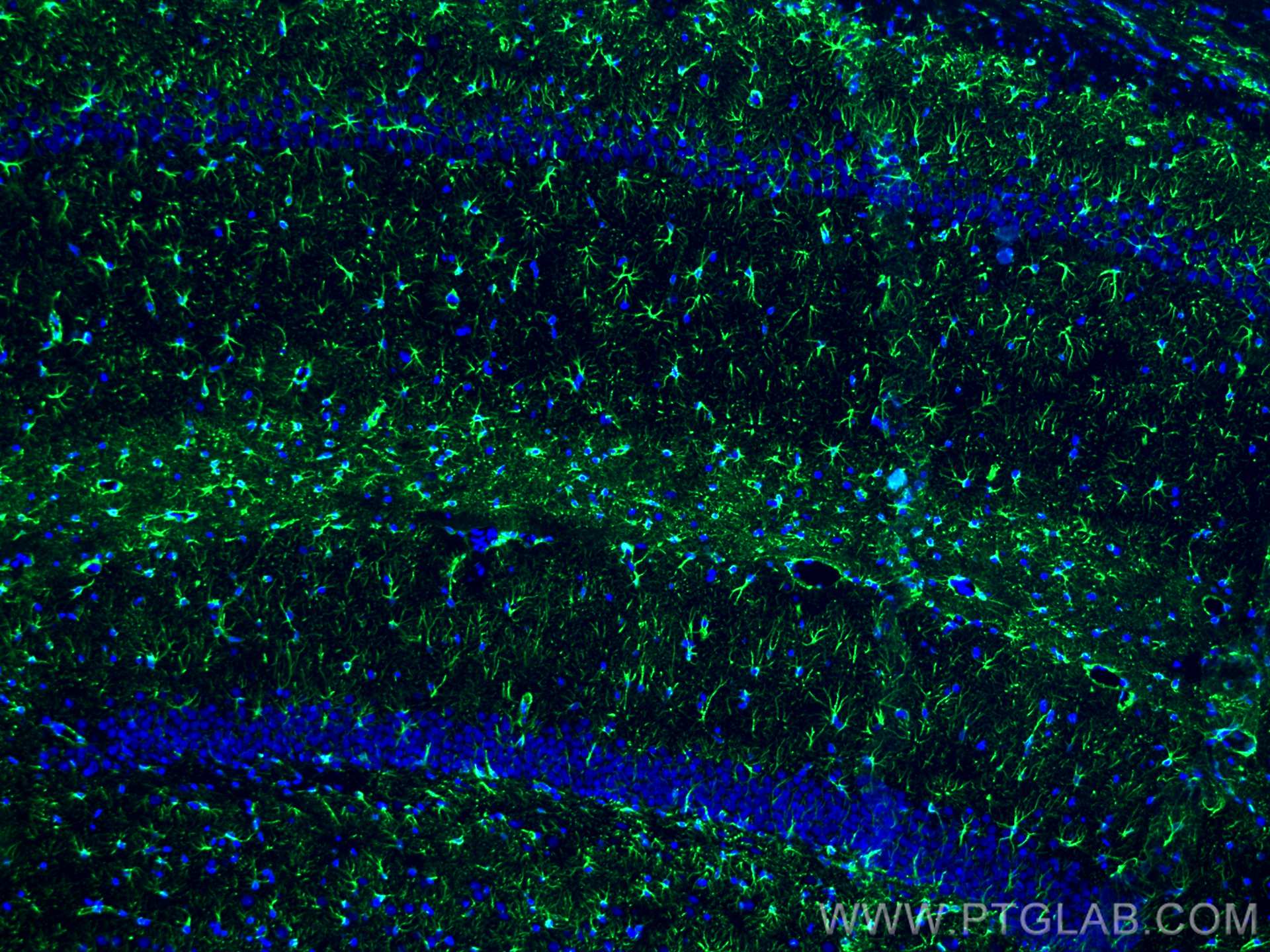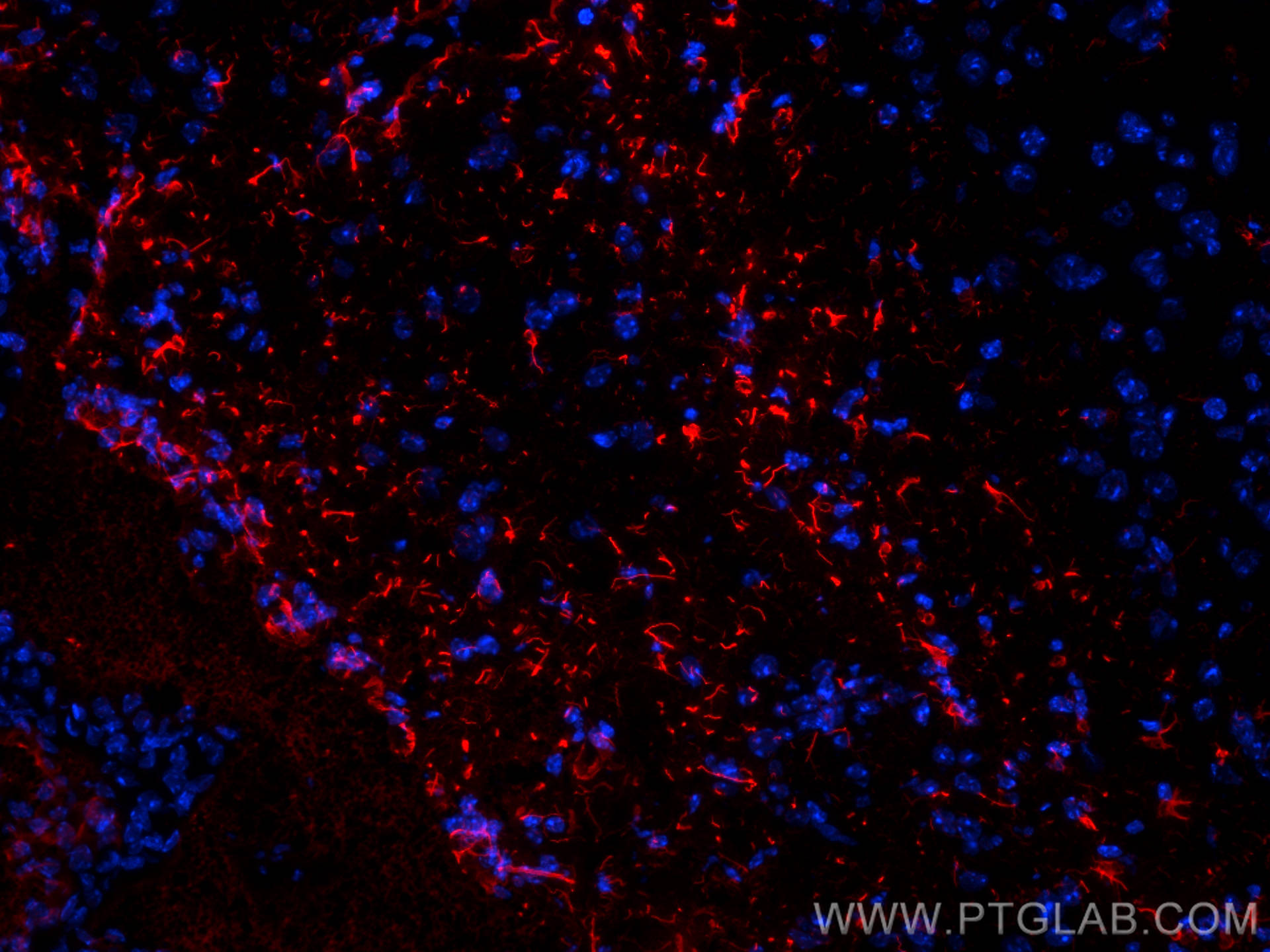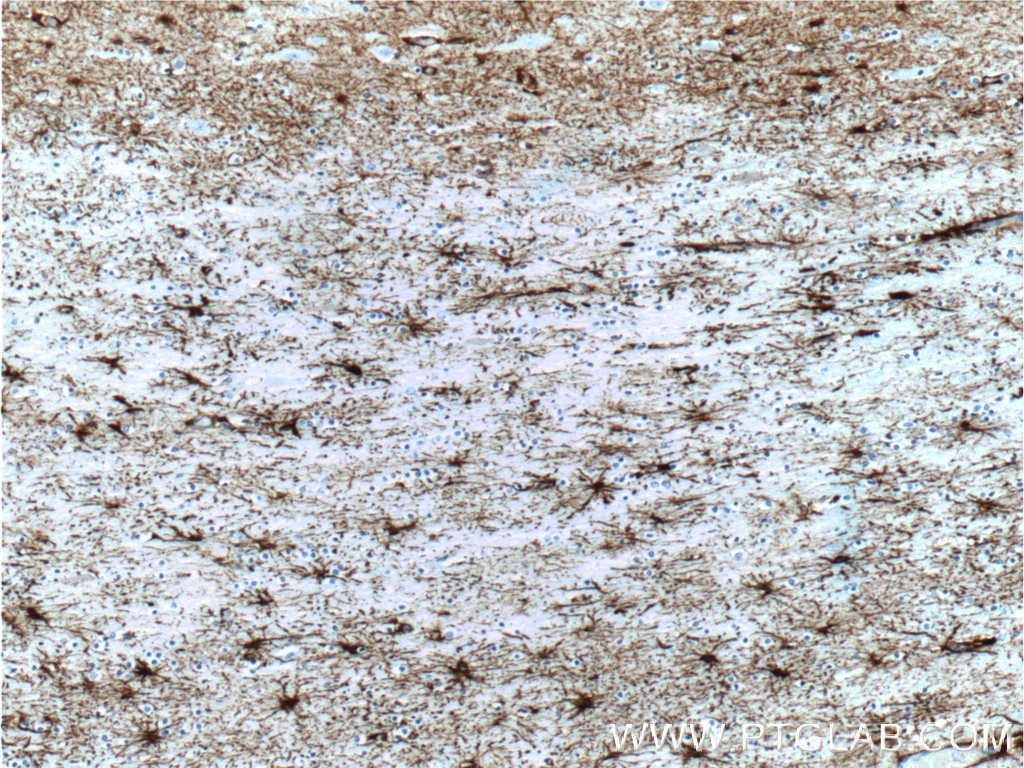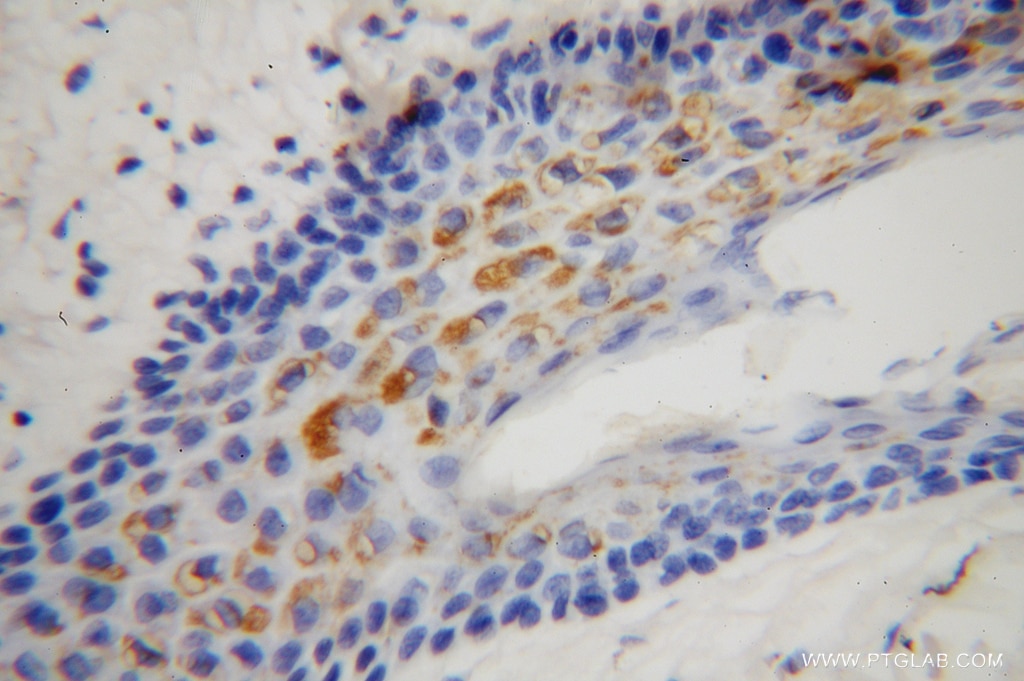- Phare
- Validé par KD/KO
Anticorps Polyclonal de lapin anti-GFAP
GFAP Polyclonal Antibody for WB, IHC, IF-P, IF-Fro, ELISA
Hôte / Isotype
Lapin / IgG
Réactivité testée
Humain, rat, souris et plus (5)
Applications
WB, IHC, IF-P, IF-Fro, ELISA
Conjugaison
Non conjugué
505
N° de cat : 16825-1-AP
Synonymes
Galerie de données de validation
Applications testées
| Résultats positifs en WB | tissu cérébral de souris, cellules U-251, tissu cérébral de rat |
| Résultats positifs en IHC | tissu cérébral de souris, souris Alzheimer il est suggéré de démasquer l'antigène avec un tampon de TE buffer pH 9.0; (*) À défaut, 'le démasquage de l'antigène peut être 'effectué avec un tampon citrate pH 6,0. |
| Résultats positifs en IF-P | tissu cérébral de rat, tissu cérébral de souris |
| Résultats positifs en IF-Fro | tissu cérébral de souris, |
Dilution recommandée
| Application | Dilution |
|---|---|
| Western Blot (WB) | WB : 1:2000-1:10000 |
| Immunohistochimie (IHC) | IHC : 1:2500-1:10000 |
| Immunofluorescence (IF)-P | IF-P : 1:50-1:500 |
| Immunofluorescence (IF)-FRO | IF-FRO : 1:500-1:2000 |
| It is recommended that this reagent should be titrated in each testing system to obtain optimal results. | |
| Sample-dependent, check data in validation data gallery | |
Applications publiées
| WB | See 148 publications below |
| IHC | See 83 publications below |
| IF | See 340 publications below |
Informations sur le produit
16825-1-AP cible GFAP dans les applications de WB, IHC, IF-P, IF-Fro, ELISA et montre une réactivité avec des échantillons Humain, rat, souris
| Réactivité | Humain, rat, souris |
| Réactivité citée | rat, Chèvre, Humain, poisson-zèbre, porc, souris, Hamster, duck |
| Hôte / Isotype | Lapin / IgG |
| Clonalité | Polyclonal |
| Type | Anticorps |
| Immunogène | GFAP Protéine recombinante Ag10423 |
| Nom complet | glial fibrillary acidic protein |
| Masse moléculaire calculée | 432 aa, 50 kDa |
| Poids moléculaire observé | 45-50 kDa |
| Numéro d’acquisition GenBank | BC013596 |
| Symbole du gène | GFAP |
| Identification du gène (NCBI) | 2670 |
| Conjugaison | Non conjugué |
| Forme | Liquide |
| Méthode de purification | Purification par affinité contre l'antigène |
| Tampon de stockage | PBS avec azoture de sodium à 0,02 % et glycérol à 50 % pH 7,3 |
| Conditions de stockage | Stocker à -20°C. Stable pendant un an après l'expédition. L'aliquotage n'est pas nécessaire pour le stockage à -20oC Les 20ul contiennent 0,1% de BSA. |
Informations générales
Function
GFAP (Glial fibrillary acidic protein) is a type III intermediate filament (IF) protein specific to the central nervous system (CNS). GFAP is one of the main components of the intermediate filament network in astrocytes and has been proposed as playing a role in cell migration, cell motility, maintaining mechanical strength, and in mitosis.Tissue specificity
GFAP is expressed in central nervous system cells, predominantly in astrocytes. GFAP is commonly used as an astrocyte marker. However, GFAP is also present in peripheral glia and in non-CNS cells, including fibroblasts, chondrocytes, lymphocytes, and liver stellate cells (PMID: 21219963).Involvement in disease
- Mutations in GFAP lead to Alexander disease (OMIM: 203450), an autosomal dominant CNS disorder. The mutations present in affected individuals are thought to be gain-of-function.
- Upregulation of GFAP is a hallmark of reactive astrocytes, in which GFAP is present in hypertrophic cellular processes. Reactive astrogliosis is present in many neurological disorders, such as stroke, various neurodegenerative diseases (including Alzheimer's and Parkinson's disease), and neurotrauma.
Isoforms
Astrocytes express 10 different isoforms of GFAP that differ in the rod and tail domains (PMID: 25726916), which means that they differ in molecular size. Isoform expression varies during the development and across different subtypes of astrocytes. Not all isoforms are upregulated in reactive astrocytes.Post-translational modifications
Intermediate filament proteins are regulated by phosphorylation. Six phosphorylation sites have been identified in GFAP protein, at least some of which are reported to control filament assembly (PMID: 21219963).Cellular localization
GFAP localizes to intermediate filaments and stains well in astrocyte cellular processes.Protocole
| Product Specific Protocols | |
|---|---|
| WB protocol for GFAP antibody 16825-1-AP | Download protocol |
| IHC protocol for GFAP antibody 16825-1-AP | Download protocol |
| IF protocol for GFAP antibody 16825-1-AP | Download protocol |
| Standard Protocols | |
|---|---|
| Click here to view our Standard Protocols |
Publications
| Species | Application | Title |
|---|---|---|
Nat Metab Mitochondrial fission drives neuronal metabolic burden to promote stress susceptibility in male mice | ||
Nat Commun Schwann cells regulate tumor cells and cancer-associated fibroblasts in the pancreatic ductal adenocarcinoma microenvironment | ||
Nat Commun Bicarbonate signalling via G protein-coupled receptor regulates ischaemia-reperfusion injury | ||
J Extracell Vesicles Neuron-derived extracellular vesicles contain synaptic proteins, promote spine formation, activate TrkB-mediated signalling and preserve neuronal complexity | ||
Acta Pharm Sin B Honokiol alleviated neurodegeneration by reducing oxidative stress and improving mitochondrial function in mutant SOD1 cellular and mouse models of amyotrophic lateral sclerosis |
Avis
The reviews below have been submitted by verified Proteintech customers who received an incentive forproviding their feedback.
FH Vikas (Verified Customer) (07-11-2024) | Used for IF, Worked very well, Highly recommended.
|
FH manohar (Verified Customer) (03-06-2024) |
|
FH Badrieh (Verified Customer) (08-02-2022) | this Antibody worked really great with different Recombinant GFAP proteins in ELISA.
|
FH Silvia (Verified Customer) (09-30-2021) | Immunofluorescence works well on U251-MG human astrocytoma cell line
|
FH Azita (Verified Customer) (05-31-2021) | The human primary cortical cells (DIV28) were subjected to ICC using GFAP antibody (at 1/500 dilution) overnight at 4°C.
|
FH Diane (Verified Customer) (01-03-2020) | I have used this antibody successfully for formalin-fixed paraffin-embedded brain tissues in humans, mouse and rat. I am impressed that there is no non-specific background staining regardless of species. We have used the antibody in a double-staining technique and were able to achieve crisp diagnostic staining for images. The astrocytes were stained using alkaline phosphatase Permanent Red. Antigen retrieval was performed using proteinase K.
 |
FH Tanusree (Verified Customer) (12-03-2019) | This antibody works good immuno-fluorescence and western blotting analysis using mouse brain tissues.
|
FH Ryan (Verified Customer) (02-14-2018) | NaCit antigen retrieval ph=6
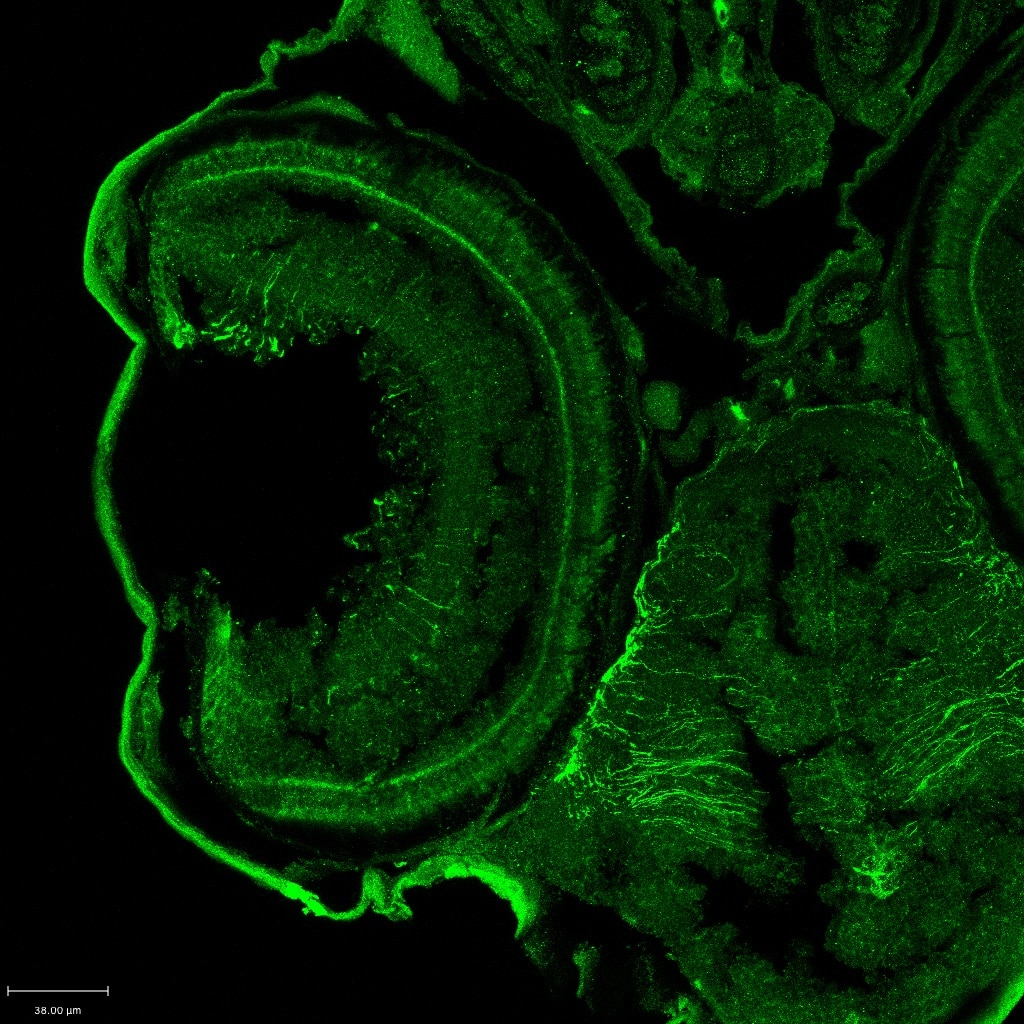 |





